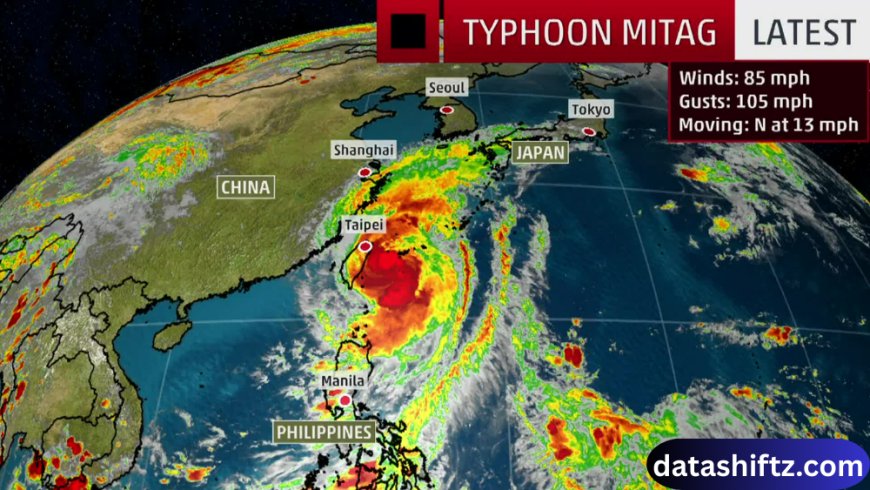Typhoon: Understanding Nature’s Fierce Storms

Introduction
Typhoons are among the most powerful and destructive natural disasters on Earth. Forming over warm tropical oceans, these massive storm systems bring fierce winds, torrential rain, and dangerous storm surges. Known as “hurricanes” in the Atlantic and “cyclones” in the Indian Ocean, typhoons are specifically the tropical cyclones that develop in the Northwest Pacific region.
Every year, typhoons affect millions of people across Asia, particularly in the Philippines, China, Taiwan, and Japan. With climate change intensifying weather events, understanding typhoons is more important than ever. This article explores the science behind typhoons, their impacts, historical examples, preparedness strategies, and why global cooperation is essential in addressing these natural hazards.
What Is a Typhoon?
Defining Typhoons
A typhoon is a mature tropical cyclone formed in the Northwest Pacific Ocean, typically between May and October, though they can occur year-round. To qualify as a typhoon, a storm must have sustained wind speeds of at least 74 mph (119 km/h).
Characteristics of Typhoons
-
Warm Core Systems: They gain energy from the evaporation of warm ocean water.
-
Low Pressure Centers: At the eye of the typhoon, atmospheric pressure is extremely low.
-
Spiraling Winds: Counterclockwise in the Northern Hemisphere.
-
Rainbands: Extend hundreds of miles, bringing widespread rainfall.
-
Storm Surge: Rising seawater pushed by strong winds causes coastal flooding.
Formation of Typhoons
The Conditions Needed
For a typhoon to form, several factors must align:
-
Warm Sea Surface Temperatures (at least 26.5°C or 80°F).
-
High Humidity in the lower to middle atmosphere.
-
Low Vertical Wind Shear so winds don’t tear the system apart.
-
Coriolis Effect to provide the necessary spin (near the equator, this effect is too weak).
Stages of Development
-
Tropical Disturbance – A cluster of thunderstorms forms.
-
Tropical Depression – Winds below 39 mph, organized circulation.
-
Tropical Storm – Winds between 39–73 mph, named by meteorological agencies.
-
Typhoon – Winds exceed 74 mph, system intensifies into a major storm.
Impacts of Typhoons
Human & Environmental Costs
Typhoons leave devastating effects:
-
Loss of Life: Thousands may perish from flooding, winds, and landslides.
-
Property Damage: Homes, schools, and infrastructure are destroyed.
-
Economic Losses: Billions of dollars lost in agriculture, fishing, and commerce.
-
Environmental Effects: Erosion, deforestation, and contamination of water supplies.
Historical Examples
-
Typhoon Haiyan (2013): One of the strongest typhoons ever recorded, devastated the Philippines with winds of 195 mph and storm surges that killed over 6,000 people.
-
Typhoon Tip (1979): The largest tropical cyclone on record, stretching 1,380 miles across with a pressure of 870 mb, the lowest ever measured.
-
Typhoon Hagibis (2019): Caused widespread flooding in Japan, with damages exceeding $15 billion.
Comparison of Major Typhoons
| Typhoon | Year | Peak Wind Speed | Lowest Pressure | Impacted Regions | Estimated Death Toll |
|---|---|---|---|---|---|
| Haiyan (Yolanda) | 2013 | 195 mph (315 km/h) | 895 mb | Philippines, Vietnam | 6,300+ |
| Tip | 1979 | 190 mph (305 km/h) | 870 mb | Japan, Pacific Ocean | 100+ |
| Hagibis | 2019 | 160 mph (260 km/h) | 915 mb | Japan | 100+ |
| Mangkhut | 2018 | 180 mph (285 km/h) | 905 mb | Philippines, Hong Kong, China | 134 |
| Vera | 1959 | 160 mph (260 km/h) | 895 mb | Japan | 5,000+ |
Preparedness and Safety Measures
Before a Typhoon
-
Stock up on food, water, and medical supplies.
-
Secure windows, roofs, and outdoor objects.
-
Prepare an emergency kit with flashlights, batteries, and first-aid supplies.
-
Follow evacuation advisories from authorities.
During a Typhoon
-
Stay indoors and away from windows.
-
Avoid coastal areas and rivers due to flooding risks.
-
Listen to emergency broadcasts for updates.
-
Use text messages instead of phone calls to preserve network capacity.
After a Typhoon
-
Check for structural damage before re-entering buildings.
-
Avoid flooded areas due to electrocution and contamination risks.
-
Assist in community clean-up and relief efforts.
-
Seek medical care if injured.
Key Facts About Typhoons
-
Typhoons are the same phenomenon as hurricanes and cyclones—only the name differs by region.
-
The Philippines experiences about 20 typhoons annually, the most of any country.
-
The eye of a typhoon is calm, but the surrounding eyewall has the strongest winds.
-
Typhoon Tip (1979) was so large it could cover the entire U.S. mainland.
-
Global warming is causing more intense typhoons, with stronger winds and heavier rainfall.
-
Coastal areas are at greatest risk due to storm surge flooding.
-
Some typhoons cause secondary disasters like landslides, dam breaks, and disease outbreaks.
-
Satellites and advanced forecasting systems have reduced death tolls, though property losses remain high.
-
International cooperation through organizations like WMO (World Meteorological Organization) helps track and name typhoons.
-
Typhoons play a role in the global water cycle, redistributing heat and moisture across the planet.
Global Response and Climate Considerations
With climate change warming oceans, scientists predict more Category 4 and 5 typhoons in the coming decades. Rising sea levels further increase the risks of storm surges. Nations like the Philippines, Japan, and China are investing in:
-
Stronger evacuation systems
-
Flood-resistant infrastructure
-
Community awareness programs
-
International disaster relief cooperation
The challenge is not just scientific but humanitarian—balancing development in coastal areas while keeping populations safe.
Conclusion
Typhoons are awe-inspiring yet terrifying natural events that demonstrate the raw power of Earth’s atmosphere. While they bring destruction, they also highlight human resilience and the importance of preparedness. By studying their patterns, improving forecasts, and strengthening infrastructure, societies can mitigate the risks they pose.
In a warming world, typhoons may grow stronger, but awareness, science, and global cooperation remain our best defenses. Understanding typhoons is not just about tracking storms—it’s about respecting nature and preparing for the future.





























